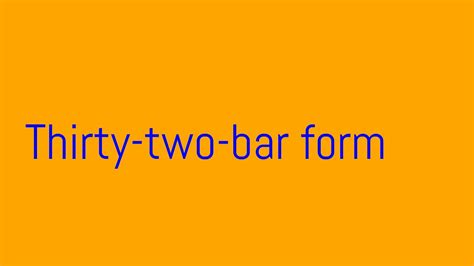The thirty-two bar form, also known as the AABA form, is a common musical structure used in songwriting and composition. This form is widely used in popular music, jazz, and musical theater, and is a staple of many classic songs. In this article, we will explore the thirty-two bar form, its history, and how it is used in music composition.
The thirty-two bar form is characterized by its eight-bar phrases, with a specific pattern of repetition and contrast. The form consists of four sections: A, A, B, and A, with each section typically lasting eight bars. The A sections usually have a similar melody and harmony, while the B section provides contrast and adds variety to the song.

History of the Thirty-Two Bar Form
The thirty-two bar form has its roots in the Tin Pan Alley era of songwriting, which spanned from the late 19th to the early 20th centuries. During this time, songwriters such as Jerome Kern, George Gershwin, and Irving Berlin popularized the form, using it to write hit songs that are still widely known today.
The form was also used extensively in jazz and musical theater, with composers like Cole Porter and Richard Rodgers using it to write complex and sophisticated songs. In the 1950s and 1960s, the thirty-two bar form was used by popular songwriters like Lennon and McCartney, and it remains a popular choice for songwriters today.
How the Thirty-Two Bar Form Works
The thirty-two bar form is characterized by its use of repetition and contrast. The A sections typically have a similar melody and harmony, while the B section provides contrast and adds variety to the song.
The first A section usually introduces the main theme of the song, with a memorable melody and harmonic progression. The second A section develops the theme, often with slight variations or additions.
The B section, also known as the "bridge," provides contrast to the A sections. It often features a new melody, harmony, or rhythm, and serves to add variety and interest to the song.
The final A section typically returns to the main theme, often with a sense of resolution or finality.
Using the Thirty-Two Bar Form in Music Composition
So how can you use the thirty-two bar form in your own music composition? Here are some tips:
- Start with a strong A section: Your first A section should introduce the main theme of your song, with a memorable melody and harmonic progression.
- Develop the theme: In your second A section, develop the theme by adding slight variations or additions.
- Create contrast with the B section: Use the B section to provide contrast to the A sections, with a new melody, harmony, or rhythm.
- Resolve with the final A section: In your final A section, return to the main theme, often with a sense of resolution or finality.

Examples of the Thirty-Two Bar Form in Music
The thirty-two bar form has been used in countless songs across many genres. Here are a few examples:
- "Yesterday" by The Beatles: This classic song uses the thirty-two bar form, with a memorable A section and a contrasting B section.
- "My Funny Valentine" by Richard Rodgers: This jazz standard uses the thirty-two bar form, with a complex and sophisticated melody and harmony.
- "Somewhere Over the Rainbow" by Harold Arlen: This classic song from "The Wizard of Oz" uses the thirty-two bar form, with a memorable A section and a contrasting B section.
Variations on the Thirty-Two Bar Form
While the thirty-two bar form is a common musical structure, it is not set in stone. Many songwriters and composers have experimented with variations on the form, adding their own twists and turns.
One common variation is the use of a "tag" at the end of the song, which is a short section that adds a final touch to the song. Another variation is the use of a "pre-chorus," which is a section that comes before the chorus and adds variety to the song.

Conclusion
The thirty-two bar form is a powerful tool for music composition, offering a flexible and versatile structure for songwriters and composers. By understanding the history and mechanics of the form, you can use it to write your own songs and compositions.
Remember to start with a strong A section, develop the theme, create contrast with the B section, and resolve with the final A section. Experiment with variations on the form, and don't be afraid to add your own twists and turns.
By mastering the thirty-two bar form, you can write songs that are memorable, sophisticated, and effective.

We hope this article has been helpful in understanding the thirty-two bar form. Do you have any questions or comments? Share them with us in the comments section below.
What is the thirty-two bar form?
+The thirty-two bar form, also known as the AABA form, is a common musical structure used in songwriting and composition. It consists of four sections: A, A, B, and A, with each section typically lasting eight bars.
How is the thirty-two bar form used in music composition?
+The thirty-two bar form is used in music composition by starting with a strong A section, developing the theme, creating contrast with the B section, and resolving with the final A section. Songwriters and composers can experiment with variations on the form, adding their own twists and turns.
What are some examples of the thirty-two bar form in music?
+Examples of the thirty-two bar form in music include "Yesterday" by The Beatles, "My Funny Valentine" by Richard Rodgers, and "Somewhere Over the Rainbow" by Harold Arlen.
